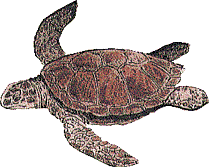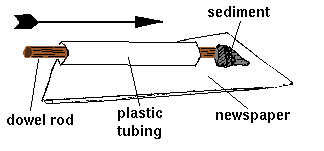
At this station your team will examine the different types of sediment at your
aquatic site. The color, odor, and particle size of the sediment provide
important information about the health of an aquatic environment.
Sediments are particles deposited onto the bottom of an aquatic site through
the action of rivers, glaciers, or wind. The kinds of sediments deposited are
important, because they help determine the drainage of the site. The finer the
sediments, the less the water is able to drain through the site. Some drainage
is beneficial, because de-oxygenated water or heavier pollutants can drain
away. A well-drained aquatic site usually supports a larger variety of
organisms than a poorly drained aquatic site.
Materials
For the Pre-Field station:
- PVC tubing, 60 cm (about 2 ft) long and 5 cm (about 2 in) in diameter
- Dowel rod, 60 cm (about 2 ft) long and 5 cm (about 2 in) in diameter
- Hammer
- Newspaper
- Magnifying glass
- Copy of Master 4d, "Sediment Sizing Chart" for each research team
For the Field Experiment:
- Corer (tube and dowel from the Pre-Field Experiment above)
- Hammer
- Newspaper
- Magnifying glass
- Your team's copy of Master 4a, "Baseline Study and Possible Human Impact
Assessment Form"
- Copy of Master 4d, "Sediment Sizing Chart" for each research team
Methods
Pre-Field Experiment:
To remove layers of sediment from the water, you will use an instrument
called a corer. Your corer will consist of a PVC tube and a long rod.
- To practice using your corer, find a location in the school yard where the
ground is not too hard. Hold the tube perpendicular to the surface of the
ground. Push it down as far as you can into the ground. Use a hammer if
necessary to get the tube into the ground. If the soil is too sandy or soft, wet
it with water so that the sample will pack into the corer.
- Remove the tube from the ground. Insert the rod into the tube and push
the sample out of the tube onto several large sheets of newspaper.
- Examine the sample to see if it contains different types of materials (sand,
pebbles, large rocks, other objects). Try to categorize the materials you found
using Master 4d, "Sediment Sizing Chart."
Field Experiment
You will be using the corer you used in the Pre-Field Experiment to examine
the sediment in different locations at your aquatic site.
- Take your first sample at the edge of the water at your aquatic site. Hold the
tube perpendicular to the ground and press down. Use a hammer if necessary.

- Remove the tube from the ground and use the rod to push the sample onto
the newspaper.
- Examine the sample to see if the sediment contains particles of different
sizes. Describe each element of the sediment, using the sediment sizing chart
in Master 4d. Record your observations in your JASON Journal.
- Describe the texture of each element of the sediment. Rub a sample of each
layer between your fingers. Does it feel smooth? Gritty? Sticky? What else do
you notice about your sample (e.g., does it have an odor?) Record your
observations in your JASON Journal.
- Draw your findings in the Sample 1 column of the table below. Use the
illustrations in Master 4d, "Sediment Sizing Chart," as a drawing guide. For
example, if the very top of your sample contained pebbles, draw pebbles in the
first row of the column marked Sample 1. If there was a large layer of coarse
sand under the pebbles, draw coarse sand in the second and third rows of the
column marked Sample 1. If the bottom of your sample was silt, draw silt in
the last row of the Sample 1 column.
- Repeat steps 1Ð5 at a site that is 5 meters away from the water. Fill in the
column labeled Sample 2 on the Site illustration above.
- Repeat steps 1Ð5 at a site that is 10 meters away from the water. Fill in the
column labeled Sample 3 on the Site illustration above.
- Did each of your three samples contain similar types of sediment? How is
the sediment within each sample different? Is this the same for all
samples? How do the layers in one sample compare to another (for
example, was the bottom of every sample the same or different)? Record
your answers in your JASON Journal.
Conclusions
After you have conducted both the Pre-Field and Field Experiments, discuss
the following questions within your research team and record your answers
in your JASON Journal.
- How is the sediment in an aquatic environment sampled, and what does
itindicate about the water's ability to support life?
- What new questions do you have?
- Look for more answers to your questions in JASON Online Systems, the
library, and science text books.

Return to the Aquatic Field Investigation
JASON VII Home Page


JASON Project Homepage ||
Teachers' Guide ||
Students' Corner ||
Search
Gene Carl Feldman
(gene@seawifs.gsfc.nasa.gov)
(301) 286-9428
Todd Carlo Viola, JASON Foundation for Education (todd@jason.org)
Revised: 3 Nov 1995


![]()
![]()